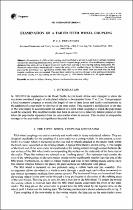JavaScript is disabled for your browser. Some features of this site may not work without it.
- ResearchSpace
- →
- Research Publications/Outputs
- →
- Journal Articles
- →
- View Item
| dc.contributor.author |
Fernandes, PJL

|
en_US |
| dc.date.accessioned | 2007-02-08T06:43:30Z | en_US |
| dc.date.accessioned | 2007-06-07T10:06:35Z | |
| dc.date.available | 2007-02-08T06:43:30Z | en_US |
| dc.date.available | 2007-06-07T10:06:35Z | |
| dc.date.issued | 1998-03 | en_US |
| dc.identifier.citation | Fernandes, PJL. 1998. Examination of a failed fifth wheel coupling. Engineering failure analysis, vol 5 (1), pp 29-33 | en_US |
| dc.identifier.issn | 1350-6307 | en_US |
| dc.identifier.uri | http://hdl.handle.net/10204/1623 | en_US |
| dc.identifier.uri | http://hdl.handle.net/10204/1623 | |
| dc.description.abstract | Examination of a fifth wheel coupling which had failed in service showed that it had been modified and that the operating handle had been moved from its original design position. This modification completely eliminated the safety device designed to prevent inadvertent opening of the coupling locking mechanism. No alternative safety device was employed to ensure the safety of the modified design. Furthermore, the rubbing plate on the pup-trailer was significantly smaller than that on the fifth wheel, with the result that the load transfer conditions were not optimal. This may have resulted in excessive damage to the wearing components such as the locking jaw, the locking bar and the king pin. And this damage could be due to non-optimum design conditions. As such, the uncoupling of the fifth wheel during operation is believed to be a direct result of the modified configuration of the locking mechanism of the fifth this failure illustrates the inherent danger in modifying established and proven designs of safety critical components. | en_US |
| dc.format.extent | 334238 bytes | en_US |
| dc.format.mimetype | application/pdf | en_US |
| dc.language.iso | en | en_US |
| dc.publisher | Pergamon-Elsevier Science Ltd | en_US |
| dc.rights | Copyright: 1998 Pergamon-Elsevier Science Ltd | en_US |
| dc.subject | Automotive failures | en_US |
| dc.subject | Bearing failures | en_US |
| dc.subject | Mechanical connections | en_US |
| dc.subject | Road safety | en_US |
| dc.title | Examination of a failed fifth wheel coupling | en_US |
| dc.type | Article | en_US |
| dc.identifier.apacitation | Fernandes, P. (1998). Examination of a failed fifth wheel coupling. http://hdl.handle.net/10204/1623 | en_ZA |
| dc.identifier.chicagocitation | Fernandes, PJL "Examination of a failed fifth wheel coupling." (1998) http://hdl.handle.net/10204/1623 | en_ZA |
| dc.identifier.vancouvercitation | Fernandes P. Examination of a failed fifth wheel coupling. 1998; http://hdl.handle.net/10204/1623. | en_ZA |
| dc.identifier.ris | TY - Article AU - Fernandes, PJL AB - Examination of a fifth wheel coupling which had failed in service showed that it had been modified and that the operating handle had been moved from its original design position. This modification completely eliminated the safety device designed to prevent inadvertent opening of the coupling locking mechanism. No alternative safety device was employed to ensure the safety of the modified design. Furthermore, the rubbing plate on the pup-trailer was significantly smaller than that on the fifth wheel, with the result that the load transfer conditions were not optimal. This may have resulted in excessive damage to the wearing components such as the locking jaw, the locking bar and the king pin. And this damage could be due to non-optimum design conditions. As such, the uncoupling of the fifth wheel during operation is believed to be a direct result of the modified configuration of the locking mechanism of the fifth this failure illustrates the inherent danger in modifying established and proven designs of safety critical components. DA - 1998-03 DB - ResearchSpace DP - CSIR KW - Automotive failures KW - Bearing failures KW - Mechanical connections KW - Road safety LK - https://researchspace.csir.co.za PY - 1998 SM - 1350-6307 T1 - Examination of a failed fifth wheel coupling TI - Examination of a failed fifth wheel coupling UR - http://hdl.handle.net/10204/1623 ER - | en_ZA |






